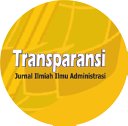Kajian Pengentasan Desa Tertinggal Melalui Pendekatan Indeks Desa Membangun
DOI:
https://doi.org/10.31334/transparansi.v4i1.1607Keywords:
Developing Village Index, Village Status, Keroncong District,Abstract
This research is motivated by the phenomenon of the number of underdeveloped villages in Keroncong District, even though the area is in the capital city of Pandeglang, not in an area far from the center of the capital city. As it is known that: Regulation of the Minister of Villages for Development of Disadvantaged Regions & Transmigration (Permendesia PDT Trans) Number 2 of 2016 concerning the Developing Village Index (IDM) classifies Village Status into 5 (five) Village statuses. Banten Province has 4 regencies which oversee the village administration. Of the four regencies, Pandeglang Regency has the most underdeveloped villages. Meanwhile, the closest sub-district to the Pandeglang Regency government and the most underdeveloped village is Keroncong District. The purpose of this study is to reveal the cause of the number of underdeveloped villages even though the area is in the center of the capital city. The locus of this research is all villages in Keroncong District. The data used is secondary data, namely from the Department of Community Empowerment of Pandeglang Regency and Banten Province and the Central Statistics Agency (BPS) of Pandeglang Regency, BPS of Banten Province. The analytical technique used in this research is descriptive qualitative analysis and content analysis. The results showed that the development of village status in Keroncong District was dominantly included in the category of underdeveloped villages. There are two villages that fall into the category of not being left behind, with the category of developing. The two villages are Bangkonol village and Pasir Karag village. Bangkonol Village has a developing status because of the easy access to the national road that crosses the Pandeglang and Lebak Regencies and has close access to the Pandeglang Regency government center. Meanwhile, Pasir Karag Village has the status of a Developing Village because of its location close to the government center of the Keroncong sub-district, the number of government public facilitiesand a high community work ethic in entrepreneurship.References
Badan Pusat Statistik Kabupaten Pandeglang. (2019a). Kabupaten Pandeglang dalam Angka 2019. Retrieved October 15, 2020, from Badan Pusat Statistik Kabupaten Pandeglang https://pandeglangkab.bps.go.id/publication/2019/08/16/9eb9c62483a57cf76de1a077/kabupaten-pandeglang-dalam-angka-2019.html
Badan Pusat Statistik Kabupaten Pandeglang. (2019b). Kecamatan Koroncong dalam Angka 2019. Retrieved from https://pandeglangkab.bps.go.id/publication/2019/09/26/301965f5112c46d37959173a/kecamatan-koroncong-dalam-angka-2019
BPS Provinsi Banten. (2019). Provinsi Banten Dalam Angka 2019. Retrieved October 15, 2020, from BPS Provinsi Banten https://banten.bps.go.id/publication/2019/08/16/15a6b8d75d924a55a581c48a/provinsi-bantendalam-angka-2019.html
Direktorat Jenderal Pembangunan dan, Pemberdayaan Masyarakat Desa, & Kementerian Desa, P. dan T. (2019). Ebook - Status Idm Provinsi-Kabupaten-Kecamatan Tahun 2019.pdf - Google Drive. Retrieved October 15, 2020, from DirektoratJenderalPembangunandan PemberdayaanMasyarakatDesa KementerianDesa,PDTdanTransmigrasi website: https://drive.google.com/file/d/1qKPIXOpJLvSN8U6s8q_PpmP8Umtuib_/view
PdtTrans, P. (2016). Peraturan Menteri Desa, Pembangunan Daerah Tertinggal dan Transmigrasi nomor 2 tahun 2016 tentang Indeks Desa Membangun. Retrieved from https://drive.google.com/file/d/1I8wHefykpt57v-tDfk3BLGn9JlMRw0FF/view?usp=sharing
Sujarweni, V. W. (2015). Akuntansi Desa : Panduan Tata Kelola Keuangan Desa. Pustaka Baru Press.
Yustisia, T. (2015). Undang-Undang Nomor 6 Tahun 2014 Tentang Desa dan Peraturan Terkait.
Retrieved from :
Downloads
Published
Issue
Section
License

This work is licensed under a Creative Commons Attribution-ShareAlike 4.0 International License
Please find the rights and licenses in Transparansi : Jurnal Ilmiah Ilmu Administrasi By submitting the article/manuscript of the article, the author(s) agree with this policy. No specific document sign-off is required.
- License
The commercial use of the article will be governed by the Creative Commons Attribution license as currently displayed on Creative Commons Attribution-ShareAlike 4.0 International License.
2. Author(s)' Warranties
The author warrants that the article is original, written by stated author(s), has not been published before, contains no unlawful statements, does not infringe the rights of others, is subject to copyright that is vested exclusively in the author and free of any third party rights, and that any necessary written permissions to quote from other sources have been obtained by the author(s).
3. User Rights
Transparansi : Jurnal Ilmiah Ilmu Administrasi spirit is to disseminate articles published are as free as possible. Under the Creative Commons license, Transparansi : Jurnal Ilmiah Ilmu Administrasi permits users to copy, distribute, display, and perform the work for non-commercial purposes only. Users will also need to attribute authors and Transparansi : Jurnal Ilmiah Ilmu Administrasi on distributing works in the journal and other media of publications.
4. Co-Authorship
If the article was jointly prepared by more than one author, any authors submitting the manuscript warrants that he/she has been authorized by all co-authors to be agreed on this copyright and license notice (agreement) on their behalf, and agrees to inform his/her co-authors of the terms of this policy. Transparansi : Jurnal Ilmiah Ilmu Administrasi will not be held liable for anything that may arise due to the author(s) internal dispute. Transparansi : Jurnal Ilmiah Ilmu Administrasi will only communicate with the corresponding author.
5. Miscellaneous
Transparansi : Jurnal Ilmiah Ilmu Administrasi will publish the article (or have it published) in the journal if the article’s editorial process is successfully completed. Transparansi : Jurnal Ilmiah Ilmu Administrasi editors may modify the article to a style of punctuation, spelling, capitalization, referencing and usage that deems appropriate. The author acknowledges that the article may be published so that it will be publicly accessible and such access will be free of charge for the readers as mentioned in point 3.
Every accepted manuscript should be accompanied by "Copyright Transfer Agreement"prior to the article publication.











